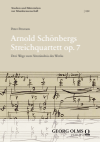Zusammenfassung
150. Geburtstag Arnold Schönberg! Arnold Schönbergs Streichquartett op. 7 gehört zu den anspruchsvollsten Kammermusikwerken der Spätromantik. Die Monographie des Hamburger Musikwissenschaftlers Peter Petersen geht das Werk aus drei Richtungen an: (1) Themen und Motive werden identifiziert, wobei ein vom Komponisten unerwähntes Thema ans Licht kommt; (2) der Verlauf des Quartettsatzes wird musikdramaturgisch analysiert und so der Aspekt der Viersätzigkeit in der Einsätzigkeit erweitert; (3) das von Schönberg verschwiegene, inzwischen bekannte Programm einer Liebesgeschichte wird in seiner ästhetischen Relevanz für das Werkganze untersucht – mit dem Ergebnis, dass es nur teilweise den Gang der Komposition gesteuert, der musikalischen Phantasie aber eine Richtung gegeben hat.
Abstract
Arnold Schönberg's String Quartet op. 7 is one of the most demanding chamber music works of the late Romantic period. The monograph by Hamburg musicologist Peter Petersen approaches the work from three directions: (1) themes and motifs are identified, whereby a theme unmentioned by the composer comes to light; (2) the course of the quartet movement is analyzed in terms of music dramaturgy, thus expanding the aspect of the four-movement structure in the single-movement structure; (3) the now well-known program of a love story, which Schönberg concealed, is examined in terms of its aesthetic relevance to the work as a whole – with the result that it only partially steered the course of the composition, but gave direction to the musical imagination.
Schlagworte
Arnold Schönberg aesthetics Ästhetik chamber music work Einsätzigkeit composition Kammermusikwerk fantasy four-movement Komposition Liebesgeschichte late romanticism love story Motive motifs Musik Musikdramaturgie music music dramaturgy Musikgeschichte Musikwissenschaft music history Peter Petersen musicology Phantasie quartet movement single-movement Quartettsatz Spätromantik string quartet Streichquartett themes Themen Viersätzigkeit- Kapitel Ausklappen | EinklappenSeiten
- 9–14 Einleitung 9–14
- 157–211 Anhang 157–211

